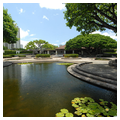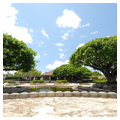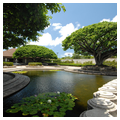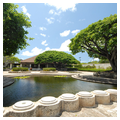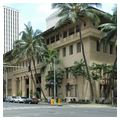A horticulturist's delight, the flora of Hawaii is as cosmopolitan as its human population. During the past two centuries, over five thousand different varieties of plants have been introduced to the Islands, providing them with the largest number of introduced plants of any geographic area on the globe. Add to this vast introduced population the fact that around 90 percent of Hawaii's approximately one thousand native species are endemic, found nowhere else in the natural world, and a landscaper has an incredibly unique and diverse palette upon which to draw. Over the years Hawaii's architects have taken full advantage of Hawaii's flora to embellish and enhance their designs, and structures such as Ala Moana Park's McCoy Pavilion celebrate the cosmopolitan character of not only the Islands' vegetation but also its society.
Hawaii's indigenous plant population arrived here many millennia before human occupation, and was brought by wing, wind, and water, that is, by seeds carried to the Islands by ocean and air currents and birds. Once established, the plants evolved to fill every niche in the eleven climate zones found in Hawaii. The world has but thirteen climate zones, thus the opportunity for diversity on these small, isolated specks of land was incredible. The Polynesian settlers to these shores further expanded the biodiversity by introducing at least twenty-six plants, including the coconut, taro, sugar cane, banana, yams, sweet potato, breadfruit, ti, kawa, kukui nut, kou, milo, kamani, and other practical plants used in their everyday life.
Westerners, like the early Polynesians, also concentrated primarily on food plants in their early introductions. Starting in the late eighteenth century and continuing through the first part of the nineteenth century, Spanish settler Don Francisco de Paula y Marin 1774–1837 successfully cultivated oranges, limes, figs, olives, grapes, beans, potatoes, tomatoes, peaches, coffee, avocado, mango, tamarind, and a host of other fruits and vegetables. He also introduced such ornamental plants as the Pride of India, Pride of Barbados, and false kamani.
Another early amateur horticulturist, German physician Wilhelm Hildebrand arrived in the Islands in 1851 and remained here for twenty years. As a member of the Royal Hawaiian Agricultural Society, he introduced the umbrageous monkeypod tree to the Islands. In 1865–1866, he traveled to China, India, and Malaysia to arrange for the importation of laborers for the nascent sugar industry, and was also provided five hundred dollars by the agricultural society and the Hawaii Sugar Planters' Association HSPA for the introduction of worthwhile plants and animals to Hawaii. His importations included camphor, cinnamon, Java plum, royal poinciana, and several kinds of eugenias and banyans. His trip also resulted in the addition of the mynah bird, as well as a number of finches and pheasants to the kingdom's avian population.
The nineteenth century was characterized by a European penchant for collecting and classifying all that the world had to offer, with plants being no exception. Municipal conservatories appeared in many European cities, their greenhouses containing tropical vegetation from the various corners of the globe. In comparison, Hawaii, thanks to its climate, was a conservatory broken loose. Residents of Hawaii returned from their travels abroad with a large variety of plants, the best the world had to offer in the way of engaging ornamental plants. Bird-of-paradise, various gingers, hibiscus, indigo, guava, yellow shower trees, date palms, and anthuriums came to adorn Hawaii's gardens and yards during the late nineteenth and early twentieth centuries. Thus near the end of the nineteenth century, Chief Justice Judd, in a paper delivered to the Social Science Club in 1891, could marvel that, “the additions made to the flora and fauna of these islands since they were discovered have been very great and have materially altered the appearance of the country and the character of its pursuits and have increased the comforts of its inhabitants.”
In 1907, University of Minnesota's professor of botany Harold Lloyd Lyon relocated to Hawaii at the request of the HSPA, and added his scientific acumen to the collection of plants. As the head of the HSPA's Department of Plant Pathology 1909–1918, which later became their Department of Botany and Forestry 1918–1936, and later still, their Experimental Station 1936–1948, Lyon traveled extensively to foreign lands to study sugar cane and, beginning in 1918, to locate suitable trees and plants to reforest Hawaii's watersheds. He brought back many plants found in today's landscapes.
With such an abundance of materials to work with, it is surprising that the profession of landscape architecture did not emerge in the Islands until the 1920s, with Richard C. Tongg OA34 being the pioneer figure in the field. In the next two decades, Catherine Jones Richards and her partner and, later, husband, Robert O. Thompson, whom she met while studying landscape design at Harvard University, became the foremost landscape designers in Hawaii during the 1930s and 1940s. Their work included the simple and gracious landscaping of the Board of Water Supply Pumping Stations and Nuuanu Aerator, as well as the courtyards at the Honolulu Academy of Arts OA91, the C. Brewer Building's courtyard OA38, Ala Moana Park OA102, and the National Cemetery of the Pacific at Punchbowl. In the post–World War II period, Thompson and Thompson frequently worked on projects designed by Vladimir Ossipoff, as did landscape architect George Walters.
Throughout the past one hundred years, exotics from other parts of the world have been the preferred landscape materials in Hawaii. Gingers in the early years, with heliconias gaining in popularity during the 1970s, and bromeliads, although introduced in the 1930s, becoming commonplace since the 1990s. Also, with a resurgence in native Hawaiian cultural awareness from the late 1970s onward has come an increasing use of native plants.
Writing Credits
If SAH Archipedia has been useful to you, please consider supporting it.
SAH Archipedia tells the story of the United States through its buildings, landscapes, and cities. This freely available resource empowers the public with authoritative knowledge that deepens their understanding and appreciation of the built environment. But the Society of Architectural Historians, which created SAH Archipedia with University of Virginia Press, needs your support to maintain the high-caliber research, writing, photography, cartography, editing, design, and programming that make SAH Archipedia a trusted online resource available to all who value the history of place, heritage tourism, and learning.


